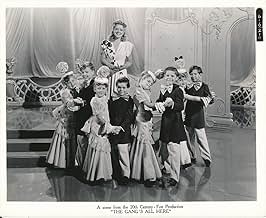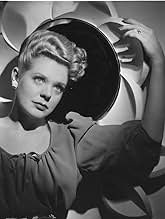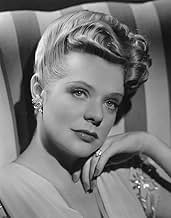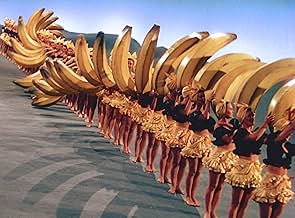VALUTAZIONE IMDb
6,6/10
2168
LA TUA VALUTAZIONE
Aggiungi una trama nella tua linguaA soldier falls for a chorus girl and then experiences trouble when he is posted to the Pacific.A soldier falls for a chorus girl and then experiences trouble when he is posted to the Pacific.A soldier falls for a chorus girl and then experiences trouble when he is posted to the Pacific.
- Regia
- Sceneggiatura
- Star
- Candidato a 1 Oscar
- 2 vittorie e 1 candidatura in totale
Benny Goodman and His Orchestra
- Benny Goodman's Orchestra
- (as Benny Goodman Orchestra)
Don Anderson
- Club New Yorker Patron
- (non citato nei titoli originali)
Leon Belasco
- Waiter
- (non citato nei titoli originali)
Brooks Benedict
- Club New Yorker Patron
- (non citato nei titoli originali)
Lee Bennett
- Club New Yorker Patron
- (non citato nei titoli originali)
William A. Boardway
- Club New Yorker Patron
- (non citato nei titoli originali)
Recensioni in evidenza
It was called "The Girls He Left Behind", when first released in Britain in 1944. In this movie I think Busby Berkeley reached the pinnacle. It was his finest effort. Carmen Miranda, wearing that tutti frutty hat was a mouth-watering revelation; along with her ability to murder the English language. Roly poly Eugene Palette, trying to get the worrisome Edward Everett Horton's mind off his wife. Handing their hats to the hat-check girl, who was the lovely June Haver. (If you blinked you would have missed her). Alice Faye? A dream in Technicolour. James Ellison in the leading romantic role. Where was John Payne? He was the usual romantic lead in these Twentieth Century Fox musical capers of the early nineteen-forties.
Weak plot? Who the hell really cared! The Benny Goodman Orchestra; those songs, and the rich Technicolour, plus the Lanky Charlotte Greenwood, blindly reaching for the telephone and answering with the cat instead, brightened this teen-aged English boy's life in those wartime years of long ago. I have watched it on television more than once. The big question though. Why oh why, has it not been released on video or, better still, DVD? Can anyone explain?
Weak plot? Who the hell really cared! The Benny Goodman Orchestra; those songs, and the rich Technicolour, plus the Lanky Charlotte Greenwood, blindly reaching for the telephone and answering with the cat instead, brightened this teen-aged English boy's life in those wartime years of long ago. I have watched it on television more than once. The big question though. Why oh why, has it not been released on video or, better still, DVD? Can anyone explain?
... from 20th Century Fox and director Busby Berkeley. The meager plot concerns Army sergeant on leave Andy Mason (James Ellison) who falls for nightclub performer Edie Allen (Alice Faye). The only problem is that Andy's already engaged to Vivian Potter (Sheila Ryan). Edie's flamboyant friend and co-worker Dorita (Carmen Miranda) tries to help, to mixed results. Also featuring Eugene Pallette, Edward Everett Horton, Phil Baker, Charlotte Greenwood, Tony De Marco, Dave Willock, Frank Faylen, June Haver and Jeanne Crain in their debuts, and Benny Goodman and His Orchestra.
The plot is naturally secondary to the musical numbers, several of which are bizarre, most notably "The Lady in the Tutti Frutti Hat", featuring chorus girls running around with giant bananas. Berkeley's camera moves around, under and above the action, shattering the pretense that these numbers are designed for a nightclub or theatrical audience, taking them strictly into the realm of cinema. The costumes are also eye-popping, even those worn in the non-musical scenes, and Miranda wears an assortment of outlandish hats. This marked the end of Alice Faye's star period. She had a cameo in the following year's Four Jills in a Jeep, and then a non-musical part in 1945's Fallen Angel, before entering into screen retirement for 17 years. The movie earned an Oscar nomination for Best Color Art Direction.
The plot is naturally secondary to the musical numbers, several of which are bizarre, most notably "The Lady in the Tutti Frutti Hat", featuring chorus girls running around with giant bananas. Berkeley's camera moves around, under and above the action, shattering the pretense that these numbers are designed for a nightclub or theatrical audience, taking them strictly into the realm of cinema. The costumes are also eye-popping, even those worn in the non-musical scenes, and Miranda wears an assortment of outlandish hats. This marked the end of Alice Faye's star period. She had a cameo in the following year's Four Jills in a Jeep, and then a non-musical part in 1945's Fallen Angel, before entering into screen retirement for 17 years. The movie earned an Oscar nomination for Best Color Art Direction.
There are films whose plots are much worse. At least this film has funny moments with Charlotte Greenwood and whenever Carmen Miranda is on the screen.
But this film is a showcase for the two sequences choreographed by Busby Berkeley. Much has been written about them, but watching them never ceases to stimulate and amaze my senses. Berkeley's sense of space is so elastic -- you feel as if he could pan and zoom through miles of space and fill it with people, trees, bananas, anything! I don't think any of his Warner Bros. films used the zoom camera with as much daring (supposedly Carmen Miranda almost got knocked off the painted donkey during rehearsals of "The Lady in the Tutti-Frutti Hat").
What is so special for me in these dance sequences is that the images and music are so well-constructed that you loose interest in following the plot and just revel and enjoy the images. People cease being human forms and become elements of color on a painted canvas, and then resume being human once again. It's all incredibly magical and more abstract than Berkeley had been or was able to achieve in the future. Stunning!
But this film is a showcase for the two sequences choreographed by Busby Berkeley. Much has been written about them, but watching them never ceases to stimulate and amaze my senses. Berkeley's sense of space is so elastic -- you feel as if he could pan and zoom through miles of space and fill it with people, trees, bananas, anything! I don't think any of his Warner Bros. films used the zoom camera with as much daring (supposedly Carmen Miranda almost got knocked off the painted donkey during rehearsals of "The Lady in the Tutti-Frutti Hat").
What is so special for me in these dance sequences is that the images and music are so well-constructed that you loose interest in following the plot and just revel and enjoy the images. People cease being human forms and become elements of color on a painted canvas, and then resume being human once again. It's all incredibly magical and more abstract than Berkeley had been or was able to achieve in the future. Stunning!
I'll get to the plot of "The Gang's All Here" in a minute, because the plot isn't the most memorable part of this movie. The most memorable part is the bananas.
About 20 minutes into the movie, a towering hat of Technicolor fruit appears on the screen, followed by its owner--'40s "Brazilian bombshell" Carmen Miranda. She proceeds to do a number called "The Lady in the Tutti-Frutti Hat," accompanied by chorus girls who bear bananas. Six-foot-tall bananas that continuously droop and sprout until number's end, when the chorus girls, worn out by the burden of this mutated fruit, lay down for a long siesta on a stage dressed up like an island.
There's a reason this number occurs so early on: It takes you the rest of the movie to convince yourself you actually saw this in a 1943 movie.
But then, this is Busby Berkeley, a director who staged his musical numbers as though he was declaring war. And next to kitsch, war is pretty much the motivator here.
The wafer-thin story involves Andy (James Ellison), a soldier who woos and wins Edie (Alice Faye), a canteen dancer, the night before Andy goes off to World War Two. In what seems an instant, Andy gets decorated and returned home to a victory party thrown by the family of Andy's childhood sweetheart and fiancee--who, unfortunately for Edie, is not Edie.
Will the heartbreak be resolved? Do you really care? The plot is mostly an excuse for some snappy repartee between major '40s stars (in particular, Eugene Pallette and Edward Everett Horton are hilarious), and the kind of musical numbers that seem to drop out of thin air. (In a couple of scenes, Benny Goodman and his orchestra stroll by and do some songs just for the heck of it.)
"The Gang's All Here" is really a 1943 time capsule, but an eye-popping rouser of one. They don't make 'em like this anymore. They didn't make 'em much like this back then, either. It's not out on video or DVD, so look for its sporadic broadcasts on cable TV.
About 20 minutes into the movie, a towering hat of Technicolor fruit appears on the screen, followed by its owner--'40s "Brazilian bombshell" Carmen Miranda. She proceeds to do a number called "The Lady in the Tutti-Frutti Hat," accompanied by chorus girls who bear bananas. Six-foot-tall bananas that continuously droop and sprout until number's end, when the chorus girls, worn out by the burden of this mutated fruit, lay down for a long siesta on a stage dressed up like an island.
There's a reason this number occurs so early on: It takes you the rest of the movie to convince yourself you actually saw this in a 1943 movie.
But then, this is Busby Berkeley, a director who staged his musical numbers as though he was declaring war. And next to kitsch, war is pretty much the motivator here.
The wafer-thin story involves Andy (James Ellison), a soldier who woos and wins Edie (Alice Faye), a canteen dancer, the night before Andy goes off to World War Two. In what seems an instant, Andy gets decorated and returned home to a victory party thrown by the family of Andy's childhood sweetheart and fiancee--who, unfortunately for Edie, is not Edie.
Will the heartbreak be resolved? Do you really care? The plot is mostly an excuse for some snappy repartee between major '40s stars (in particular, Eugene Pallette and Edward Everett Horton are hilarious), and the kind of musical numbers that seem to drop out of thin air. (In a couple of scenes, Benny Goodman and his orchestra stroll by and do some songs just for the heck of it.)
"The Gang's All Here" is really a 1943 time capsule, but an eye-popping rouser of one. They don't make 'em like this anymore. They didn't make 'em much like this back then, either. It's not out on video or DVD, so look for its sporadic broadcasts on cable TV.
"The Gang's All Here" is just pure entertainment in the old-school musical style (before Oklahoma!). There's essentially no plot, and what story there is, is full of plot-holes. It's propaganda dressed up in a musical. Don't get negative about this; music and dancing predominate and, of course, the cause is good. Made during WWII it almost subliminally reinforces home front practices during wartime, such as buying war bonds, and staying true to your man in uniform. A lot of this is probably lost to most viewers fifty years later. But think about it, and remember that when this movie was made, the Allied victory was not a sure thing.
And what about the music and dancing? Carmen Miranda in her tutti-frutti hat. Benny Goodman's swing band. Alice Faye. Busby Berkeley. If these people mean any thing to you, they are here in fine form.
And what about the music and dancing? Carmen Miranda in her tutti-frutti hat. Benny Goodman's swing band. Alice Faye. Busby Berkeley. If these people mean any thing to you, they are here in fine form.
Lo sapevi?
- QuizThe production number "The Lady In The Tutti-Frutti Hat" ran into problems with the censors. The Hayes office at first considered the way the gigantic bananas were held in front of the dancers as being too "phallic". The problem was resolved by having the dancers hold the bananas at waist level rather than at hip level.
- BlooperIncorrectly regarded as goof: As the passengers disembark the ship within the first 3 minutes of the film, a series of mechanical-looking large shadows can be easily seen moving across the painted backdrop of buildings intended to be far in the distance. This is actually a stage set of a musical production, thus not filmed as a real scene.
- Citazioni
Phil Baker: Oh, Dorita, you remember Mr. Potter and Mr. Mason.
Dorita: Ah! I remember Mr. Potty. You are here to kick up some more heels, huh?
Peyton Potter: No!
Phil Baker: Mr. Potter wants you to come to his house this weekend.
Dorita: Ah-ah-ah, you naughty boy. You are what they call a fast-work man, yes?
- ConnessioniEdited into Il caso Myra Breckinridge (1970)
- Colonne sonoreHail! Hail! The Gang's All Here!
(uncredited)
Music by Theodore Morse and Arthur Sullivan
Lyrics by Dolly Morse (as D.A. Esrom)
Sung by a chorus during the opening credits
I più visti
Accedi per valutare e creare un elenco di titoli salvati per ottenere consigli personalizzati
- How long is The Gang's All Here?Powered by Alexa
Dettagli
- Data di uscita
- Paese di origine
- Lingue
- Celebre anche come
- The Gang's All Here
- Luoghi delle riprese
- Azienda produttrice
- Vedi altri crediti dell’azienda su IMDbPro
- Tempo di esecuzione1 ora 43 minuti
- Colore
- Proporzioni
- 1.33 : 1
Contribuisci a questa pagina
Suggerisci una modifica o aggiungi i contenuti mancanti

Divario superiore
By what name was Banana Split (1943) officially released in India in English?
Rispondi





































